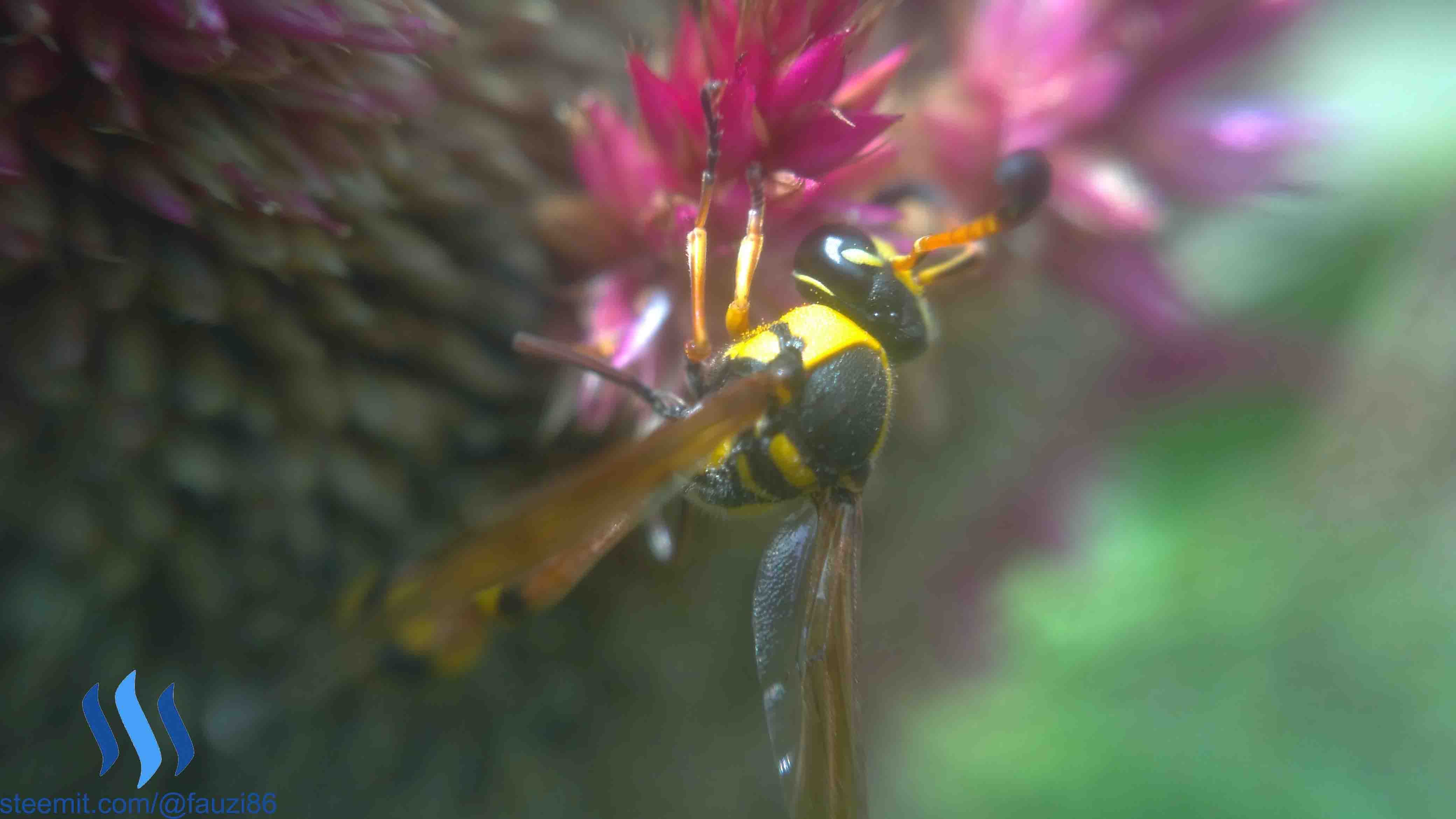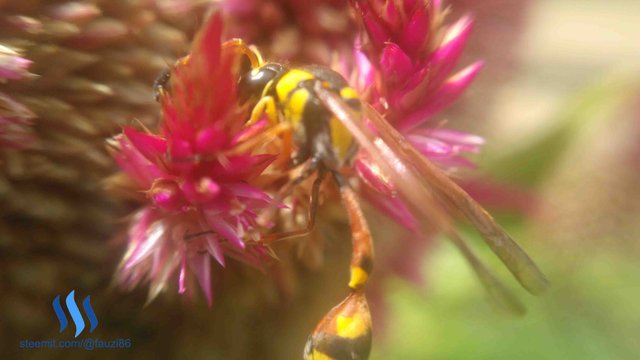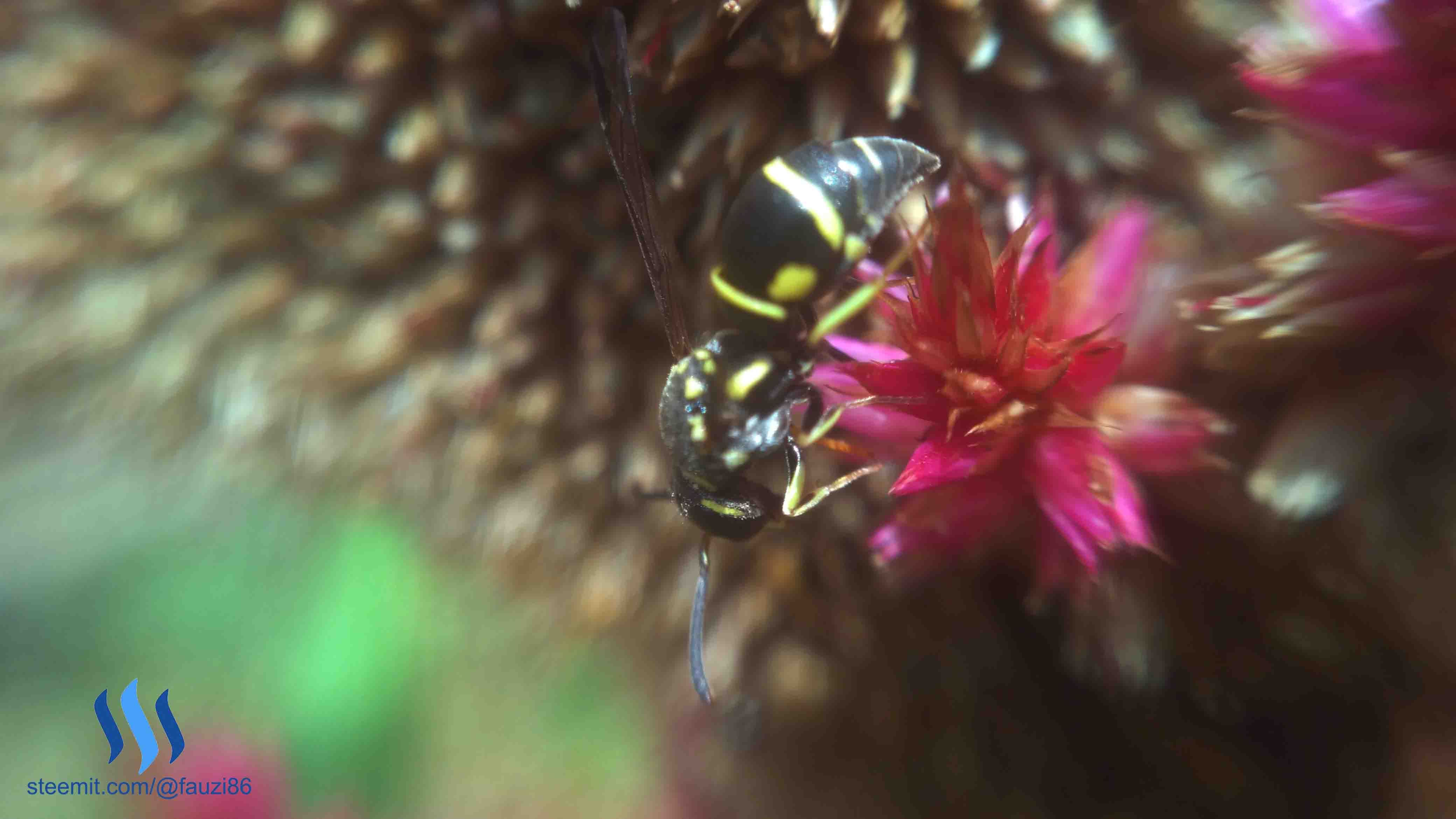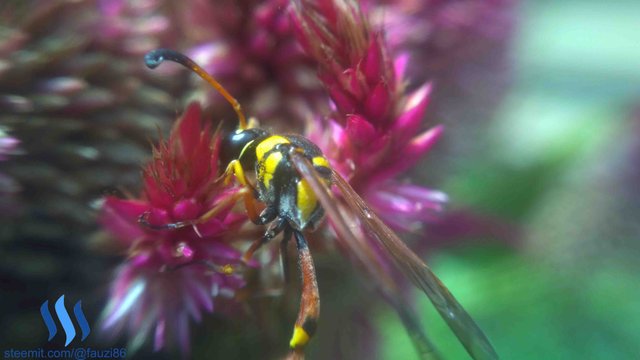In the scientific language this type of wasp is called Paravespula vulgris
Wasps are very aggressive animals, if we disturb them then they will be angry and attack with poisonous sting. They are the suckers of honey on the flowers that are in bloom. This wasp usually collects honey or flower essence in its mouth to give to the child. The wasps make their nest the same as the black wasps, they stick to the wood and the walls of the building. This wasp nest is made of clay formed with saliva.
This wasp is not the type of animal that dwells in place, usually to suck the honey contained in the flower he only takes sekiter two seconds. To approach it is not an easy thing, just a little movement then he will fly unless we take a photo by using a DSLR camera fitted with a distance lens


This type of wasp's sting is very poisonous, if our coconut is stung from this wasp as if our head is hit by a stone throw that sounds very loud in our hearing. Head swell for several days and the pain is great, the injection that is on the tail will stick to our skin when stung and continue to pump the poison in the injection.

Symptoms of Bee Stings
The form of bee sting on the skin can be marked with a small white dot in the center of the lump that appears in the central area of the sting. Symptoms of bee stings can vary and the shape is not always the same, ranging from pain that lasts until a serious allergic reaction. Some of the following symptoms of attack are considered common, ranging from mild to serious symptoms.
The pain that comes immediately after a person has been stung by a bee and can subside after a few hours.
Red lining around the sting area. In some cases, wounds may be dark red.
The area around the sting that will look slightly swollen compared to other areas and usually re-deflates after a few hours. Swelling can grow gradually over the next two to three days.
The reaction from a strong sting usually lasts for 5-10 days. Strong reaction sufferers do not mean that they will experience severe allergic reactions in subsequent stings. However, usually the patient will get the same strong reaski when stung back bees.
While most cases of bee stings are mild and do not require the care of a physician, a person whose allergic reaction becomes more severe should be alert. Severe allergic reactions can develop into anaphylactic allergic reactions that can endanger life. Immediately to the doctor to get proper treatment. Symptoms of anaphylaxis may be experienced, among others:
Reactions to the skin of an itchy itch
Pale skin
Swelling of the tongue and throat
Difficulty breathing can be caused by swelling of the throat
A weak and irregular pulse
Blood pressure dropped suddenly
Nausea, vomiting, or diarrhea
Dizziness or fainting
Missing awareness
Someone who is repeatedly stung by a bee is also likely to feel pain due to accumulation of toxins / can in the body. So also with someone who gets bee stings in a barrage must be immediately taken to the doctor. This condition can be an emergency case especially in children, elderly, and people with respiratory or cardiac problems. Symptoms to be aware of, among others:
Dizzy
Feel like circling or vertigo
Nausea, vomiting, or diarrhea
Fever
Seizures
Fainting
Diagnosis of Bee Stings
Several types of tests commonly used to diagnose insect bites or allergic reactions are allergy tests on the skin and blood tests. This test can also be used to diagnose allergic reactions from bee sting (generally wasps), including other types of bees, such as yellow jackets.
Skin testing is done by injecting small amounts of toxins / can bees in the arm or upper back area. A small lump will appear in the injection area if the patient is shown to have an allergy to bee stings.
On the other hand, a blood test is done by taking a blood sample to then be tested with some allergens that may be the cause of allergies. Patients expressed allergies when there is a significant amount of antibodies in the blood.
Treatment of Bee Stings
Bee stings can generally be handled at home to relieve the pain caused, but for those who get bee stings repeatedly and have allergies to bee stings (bees), then the patient should immediately get a medical emergency action in the Emergency Installation (IGD).
Doctors can recommend epinephrine in the form of auto injection. Injections of allergy, or immunotherapy given periodically for several years may also be advisable to reduce allergic reactions due to toxins / may be from bee stings. When anaphylactic attack occurs several drugs may be given, namely:
Adrenaline (epinephrine) to overcome the anaphylactic situation and reduce the body's reaction to allergies.
Oxygen to smooth the respiratory disturbance caused by allergy symptoms.
Drugs from the beta-agonist group to relieve symptoms associated with respiratory disorders.
Infusion of cortisone drugs and antihistamines to reduce inflammation of the airways and improve respiratory conditions.
Patients with allergies who experience anaphylactic reactions will also get help first heart resuscitation (CPR) from medical personnel as the first medical emergency measures. Warning bracelets can be used to inform the people around you about any particular allergies or health conditions and what to do in case of a medical emergency.
Here are some first-aid measures at home for minor bee-sting cases on mild and moderate levels that can be applied to children.
TThe stinging bee can not retract the stinger from the skin of the object so it must be immediately removed with a nail or clamp. Toxins / can bees can also enter the body in seconds.
Wash skin area stung with soap.
Place cold compress on the sting area.
Apply a hydrocortisone cream or calamine lotion to relieve redness, itching, or swelling.
Lift and place the affected leg or arm in a higher area than the body. Do this while sitting or lying down.
Use painkillers that can be purchased without a prescription. Choose the appropriate condition of the patient's age.
If itching is very disturbing, take antihistamine drugs to relieve them.
Do not scratch the area around the sting because it can increase the itching, swelling, and cause infected wounds
by : http://www.alodokter.com/sengatan-lebah

Beautiful post 😊 @fauzi86 just give you up vote
Downvoting a post can decrease pending rewards and make it less visible. Common reasons:
Submit
thanks you
Downvoting a post can decrease pending rewards and make it less visible. Common reasons:
Submit